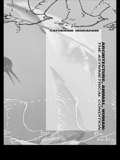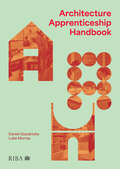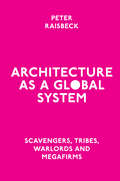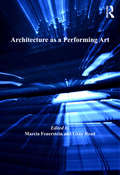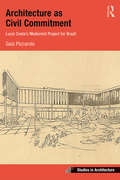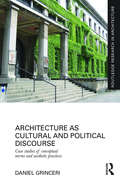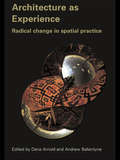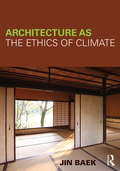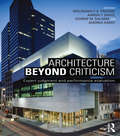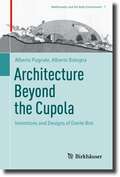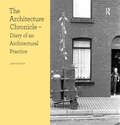- Table View
- List View
Architecture and Utopia: The Israeli Experiment (Design and the Built Environment)
by Michael ChyutinThere are more than 450 Moshavim settlements and about 270 kibbutzim in Israel. While there is a range of communal and cooperative kibbutz movements, all with slight ideological differences, they are all collective rural communities, based on an ideal to create a social utopian settlement. Placing the kibbutz within the wider context of utopian social ideals and how they have historically been physically and architecturally constructed, this book discusses the form of the 'ideal settlement' as an integral part and means for realizing a utopian doctrine. It presents an analysis of physical planning in the kibbutz through the past eight decades and how changes in ideology are reflected in changes in layout and aesthetics. In doing so, this book shows how a utopian settlement organization behaves over time, from their first appearance in 1920 on, to an examination of the current spatial layouts and the directions of their expected future development.
Architecture, Animal, Human: The Asymmetrical Condition
by Catherine T. IngrahamThis book looks at specific instances in the Renaissance, Enlightenment and our own time when architectural ideas and ideas of biological life come into close proximity with each other. These convergences are fascinating and complex, offering new insights into architecture and its role. Establishing architecture as a product of the ascendancy of the position of human life, the author shows here that while architecture is dependent on life forces for its existence, at the same time it must be, at some level, indifferent to the life within it. Life, for its part, privileges itself above all else, and seeks to continuously expand its field of expression. This, then, is the asymmetrical condition, and to understand it is to gain important new theoretical perspectives into the nature of architecture.
Architecture, Animal, Human: The Asymmetrical Condition
by Catherine T. IngrahamThis book looks at specific instances in the Renaissance, Enlightenment and our own time when architectural ideas and ideas of biological life come into close proximity with each other. These convergences are fascinating and complex, offering new insights into architecture and its role. Establishing architecture as a product of the ascendancy of the position of human life, the author shows here that while architecture is dependent on life forces for its existence, at the same time it must be, at some level, indifferent to the life within it. Life, for its part, privileges itself above all else, and seeks to continuously expand its field of expression. This, then, is the asymmetrical condition, and to understand it is to gain important new theoretical perspectives into the nature of architecture.
Architecture Apprenticeship Handbook
by Daniel Goodricke Luke MurrayArchitecture apprenticeships are a new route into the profession. Having gained traction since their inception in 2018, it is an attractive route for young generations of architects to obtain their professional qualifications and earn while they learn. Aimed at prospective and current Level 7: Architect Apprentices, this guide provides the knowledge to achieve the most from your apprenticeship education, empowering your exposure in the profession within academic and professional areas. Taking you on a journey through the apprenticeship, it presents key stages of the course through precedents and will let you know what to expect from this educational route, and when to expect it. Using case studies from recent graduates and current apprentices who have excelled through this route, it features information from employers and academics involved in architecture apprenticeship courses in the UK to provide tips, advice and guidance. Designed to be interactive, you will be able to populate and annotate the book at various stages to map the key stages of your journey and reflect on your professional development.
Architecture Apprenticeship Handbook
by Daniel Goodricke Luke MurrayArchitecture apprenticeships are a new route into the profession. Having gained traction since their inception in 2018, it is an attractive route for young generations of architects to obtain their professional qualifications and earn while they learn. Aimed at prospective and current Level 7: Architect Apprentices, this guide provides the knowledge to achieve the most from your apprenticeship education, empowering your exposure in the profession within academic and professional areas. Taking you on a journey through the apprenticeship, it presents key stages of the course through precedents and will let you know what to expect from this educational route, and when to expect it. Using case studies from recent graduates and current apprentices who have excelled through this route, it features information from employers and academics involved in architecture apprenticeship courses in the UK to provide tips, advice and guidance. Designed to be interactive, you will be able to populate and annotate the book at various stages to map the key stages of your journey and reflect on your professional development.
Architecture as a Global System: Scavengers, Tribes, Warlords and Megafirms
by Peter RaisbeckSince the 1980s the architectural profession across the world has been driven by globalisation. The factors shaping this globalisation include neo-liberal economics, digital transformation and the rise of social media against the background of the profession’s entrenched labour practices. In describing architecture as a global system, this book outlines how globalisation has shaped architecture and explores the degree to which architecture remains a distinct field of knowledge. The book identifies four categories of architects in this global system: scavengers, tribes, warlords and megafirms. By employing this institutional-logics approach, the author looks beyond the surface spectacle of iconic projects, celebrity architects and cycles of urban focused media outrage. From this perspective, the book illuminates the archipelagos and outposts of disciplinary knowledge that architectural actors traverse and highlights the frontiers at which architectural knowledge is both created and eroded. The author argues that to retain their future agency, architects must understand the contours and ecologies of practice that constitute this global system of architectural production. This book provides a clear-sighted analysis to suggest the points that need reconfiguring in this global system so that architects may yet shape and order the future of cities.
Architecture as a Global System: Scavengers, Tribes, Warlords and Megafirms
by Peter RaisbeckSince the 1980s the architectural profession across the world has been driven by globalisation. The factors shaping this globalisation include neo-liberal economics, digital transformation and the rise of social media against the background of the profession’s entrenched labour practices. In describing architecture as a global system, this book outlines how globalisation has shaped architecture and explores the degree to which architecture remains a distinct field of knowledge. The book identifies four categories of architects in this global system: scavengers, tribes, warlords and megafirms. By employing this institutional-logics approach, the author looks beyond the surface spectacle of iconic projects, celebrity architects and cycles of urban focused media outrage. From this perspective, the book illuminates the archipelagos and outposts of disciplinary knowledge that architectural actors traverse and highlights the frontiers at which architectural knowledge is both created and eroded. The author argues that to retain their future agency, architects must understand the contours and ecologies of practice that constitute this global system of architectural production. This book provides a clear-sighted analysis to suggest the points that need reconfiguring in this global system so that architects may yet shape and order the future of cities.
Architecture as a Performing Art
by Marcia Feuerstein Gray ReadHow do buildings act with people and among people in the performances of life? This collection of essays reveals a deep alliance between architecture and the performing arts, uncovering its roots in ancient stories, and tracing a continuous tradition of thought that emerges in contemporary practice. With fresh insight, the authors ask how buildings perform with people as partners, rather than how they look as formal compositions. They focus on actions: the door that offers the possibility of making a dramatic entrance, the window that frames a scene, and the city street that is transformed in carnival. The essays also consider the design process as a performance improvised among many players and offer examples of recent practice that integrates theater and dance. This collection advances architectural theory, history, and criticism by proposing the lens of performance as a way to engage the multiple roles that buildings can play, without reducing them to functional categories. By casting architecture as spatial action rather than as static form, these essays open a promising avenue for future investigation. For architects, the essays propose integrating performance into design through playful explorations that can reveal intense relationships between people and place, and among people in place. Such practices develop an architectural imagination that intuitively asks, 'How might people play out their stories in this place?' and 'How might this place spark new stories?' Questions such as these reside in the heart of all of the essays presented here. Together, they open a position in the intersection between everyday life and staged performance to rethink the role of architectural design.
Architecture as a Performing Art
by Marcia Feuerstein Gray ReadHow do buildings act with people and among people in the performances of life? This collection of essays reveals a deep alliance between architecture and the performing arts, uncovering its roots in ancient stories, and tracing a continuous tradition of thought that emerges in contemporary practice. With fresh insight, the authors ask how buildings perform with people as partners, rather than how they look as formal compositions. They focus on actions: the door that offers the possibility of making a dramatic entrance, the window that frames a scene, and the city street that is transformed in carnival. The essays also consider the design process as a performance improvised among many players and offer examples of recent practice that integrates theater and dance. This collection advances architectural theory, history, and criticism by proposing the lens of performance as a way to engage the multiple roles that buildings can play, without reducing them to functional categories. By casting architecture as spatial action rather than as static form, these essays open a promising avenue for future investigation. For architects, the essays propose integrating performance into design through playful explorations that can reveal intense relationships between people and place, and among people in place. Such practices develop an architectural imagination that intuitively asks, 'How might people play out their stories in this place?' and 'How might this place spark new stories?' Questions such as these reside in the heart of all of the essays presented here. Together, they open a position in the intersection between everyday life and staged performance to rethink the role of architectural design.
Architecture as Civil Commitment: Lucio Costa's Modernist Project for Brazil (Ashgate Studies in Architecture)
by Gaia PiccaroloArchitecture as Civil Commitment analyses the many ways in which Lucio Costa shaped the discourse of Brazilian modern architecture, tracing the roots, developments, and counter-marches of a singular form of engagement that programmatically chose to act by cultural means rather than by political ones. Split into five chapters, the book addresses specific case-studies of Costa’s professional activity, pointing towards his multiple roles in the Brazilian federal government and focusing on passages of his work that are much less known outside of Brazil, such as his role inside Estado Novo bureaucracy, his leadership at SPHAN, and his participation in UNESCO’s headquarters project, all the way to the design of Brasilia. Digging deep into the original documents, the book crafts a powerful historical reconstruction that gives the international readership a detailed picture of one of the most fascinating architects of the 20th century, in all his contradictory geniality. It is an ideal read for those interested in Brazilian modernism, students and scholars of architectural and urban planning history, socio-cultural and political history, and visual arts.
Architecture as Civil Commitment: Lucio Costa's Modernist Project for Brazil (Ashgate Studies in Architecture)
by Gaia PiccaroloArchitecture as Civil Commitment analyses the many ways in which Lucio Costa shaped the discourse of Brazilian modern architecture, tracing the roots, developments, and counter-marches of a singular form of engagement that programmatically chose to act by cultural means rather than by political ones. Split into five chapters, the book addresses specific case-studies of Costa’s professional activity, pointing towards his multiple roles in the Brazilian federal government and focusing on passages of his work that are much less known outside of Brazil, such as his role inside Estado Novo bureaucracy, his leadership at SPHAN, and his participation in UNESCO’s headquarters project, all the way to the design of Brasilia. Digging deep into the original documents, the book crafts a powerful historical reconstruction that gives the international readership a detailed picture of one of the most fascinating architects of the 20th century, in all his contradictory geniality. It is an ideal read for those interested in Brazilian modernism, students and scholars of architectural and urban planning history, socio-cultural and political history, and visual arts.
Architecture as Cultural and Political Discourse: Case studies of conceptual norms and aesthetic practices (Routledge Research in Architecture)
by Daniel GrinceriThis book is concerned with cultural and political discourses that affect the production of architecture. It examines how these discursive mechanisms and technologies combine to normalise and aestheticise everyday practices. It queries the means by which buildings are appropriated to give shape and form to political aspirations and values. Architecture is not overtly political. It does not coerce people to behave in certain ways. However, architecture is constructed within the same rules and practices whereby people and communities self-govern and regulate themselves to think and act in certain ways. This book seeks to examine these rules through various case studies including: the reconstructed Notre Dame Cathedral, the Nazi era Munich Konigsplatz, Auschwitz concentration camp and the Prora resort, Sydney’s suburban race riots, and the Australian Immigration Detention Centre on Christmas Island.
Architecture as Cultural and Political Discourse: Case studies of conceptual norms and aesthetic practices (Routledge Research in Architecture)
by Daniel GrinceriThis book is concerned with cultural and political discourses that affect the production of architecture. It examines how these discursive mechanisms and technologies combine to normalise and aestheticise everyday practices. It queries the means by which buildings are appropriated to give shape and form to political aspirations and values. Architecture is not overtly political. It does not coerce people to behave in certain ways. However, architecture is constructed within the same rules and practices whereby people and communities self-govern and regulate themselves to think and act in certain ways. This book seeks to examine these rules through various case studies including: the reconstructed Notre Dame Cathedral, the Nazi era Munich Konigsplatz, Auschwitz concentration camp and the Prora resort, Sydney’s suburban race riots, and the Australian Immigration Detention Centre on Christmas Island.
Architecture as Experience: Radical Change in Spatial Practice
by Dana Arnold Andrew BallantyneArchitecture as Experience investigates the perception and appropriation of places across intervals of time and culture. The particular concern of the volume is to bring together fresh empirical research and animate it through contact with theoretical sophistication, without overwhelming the material. The chapters establish the continuity of a particular physical object and show it in at least two alternative historical perspectives, in which recognisable features are shown in different lights. The results are often surprising, inverting the common idea of a historic place as having an enduring meaning. This book shows the insight that can be gained from learning about earlier constructions of meaning which have been derived from the same buildings that stand before us today.
Architecture as Experience: Radical Change in Spatial Practice
by Dana Arnold Andrew BallantyneArchitecture as Experience investigates the perception and appropriation of places across intervals of time and culture. The particular concern of the volume is to bring together fresh empirical research and animate it through contact with theoretical sophistication, without overwhelming the material. The chapters establish the continuity of a particular physical object and show it in at least two alternative historical perspectives, in which recognisable features are shown in different lights. The results are often surprising, inverting the common idea of a historic place as having an enduring meaning. This book shows the insight that can be gained from learning about earlier constructions of meaning which have been derived from the same buildings that stand before us today.
Architecture as the Ethics of Climate
by Jin BaekAt a time when climate and ethics have become so important to architectural debate, this book proposes an entirely new way for architects to engage with these core issues. Drawing on Tetsuro Watsuji‘s (1889-1960) philosophy, the book illuminates climate not as a collection of objective natural phenomena, but as a concrete form of bond in which "who we are"—the subjective human experience—is indivisibly intertwined with the natural phenomena. The book further elucidates the inter-personal nature of climatic experiences, criticizing a view that sees atmospheric effects of climate under the guise of personal experientialism and reinforcing the linkage between climate and ethos as the appropriateness of a setting for human affairs. This ethical premise of climate stretches the horizon of sustainability as pertaining not only to man’s solitary relationship with natural phenomena—a predominant trend in contemporary discourse of sustainability—but also to man’s relationship with man. Overcoming climatic determinism—regional determinism, too—and expanding the ethics of the inter-personal to the level where the whole and particulars are joined through the dialectics of the mutually-negating opposites, Jin Baek develops a new thesis engaging with the very urgent issues inherent in sustainable architecture. Crucially, the book explores examples that join climate and the dynamics of the inter-personal, including: Japanese vernacular residential architecture the white residential architecture of Richard Neutra contemporary architectural works and urban artifacts by Tadao Ando and Aldo Rossi Beautifully illustrated, this book is an important contribution to the discourse which surrounds architecture, climate and ethics and encourages the reader to think more broadly about how to respond to the current challenges facing the profession.
Architecture as the Ethics of Climate
by Jin BaekAt a time when climate and ethics have become so important to architectural debate, this book proposes an entirely new way for architects to engage with these core issues. Drawing on Tetsuro Watsuji‘s (1889-1960) philosophy, the book illuminates climate not as a collection of objective natural phenomena, but as a concrete form of bond in which "who we are"—the subjective human experience—is indivisibly intertwined with the natural phenomena. The book further elucidates the inter-personal nature of climatic experiences, criticizing a view that sees atmospheric effects of climate under the guise of personal experientialism and reinforcing the linkage between climate and ethos as the appropriateness of a setting for human affairs. This ethical premise of climate stretches the horizon of sustainability as pertaining not only to man’s solitary relationship with natural phenomena—a predominant trend in contemporary discourse of sustainability—but also to man’s relationship with man. Overcoming climatic determinism—regional determinism, too—and expanding the ethics of the inter-personal to the level where the whole and particulars are joined through the dialectics of the mutually-negating opposites, Jin Baek develops a new thesis engaging with the very urgent issues inherent in sustainable architecture. Crucially, the book explores examples that join climate and the dynamics of the inter-personal, including: Japanese vernacular residential architecture the white residential architecture of Richard Neutra contemporary architectural works and urban artifacts by Tadao Ando and Aldo Rossi Beautifully illustrated, this book is an important contribution to the discourse which surrounds architecture, climate and ethics and encourages the reader to think more broadly about how to respond to the current challenges facing the profession.
Architecture-Aware Optimization Strategies in Real-time Image Processing
by Chao Li Souleymane Balla-Arabe Fan YangIn the field of image processing, many applications require real-time execution, particularly those in the domains of medicine, robotics and transmission, to name but a few. Recent technological developments have allowed for the integration of more complex algorithms with large data volume into embedded systems, in turn producing a series of new sophisticated electronic architectures at affordable prices. This book performs an in-depth survey on this topic. It is primarily written for those who are familiar with the basics of image processing and want to implement the target processing design using different electronic platforms for computing acceleration. The authors present techniques and approaches, step by step, through illustrative examples. This book is also suitable for electronics/embedded systems engineers who want to consider image processing applications as sufficient imaging algorithm details are given to facilitate their understanding.
Architecture-Aware Optimization Strategies in Real-time Image Processing
by Chao Li Souleymane Balla-Arabe Fan YangIn the field of image processing, many applications require real-time execution, particularly those in the domains of medicine, robotics and transmission, to name but a few. Recent technological developments have allowed for the integration of more complex algorithms with large data volume into embedded systems, in turn producing a series of new sophisticated electronic architectures at affordable prices. This book performs an in-depth survey on this topic. It is primarily written for those who are familiar with the basics of image processing and want to implement the target processing design using different electronic platforms for computing acceleration. The authors present techniques and approaches, step by step, through illustrative examples. This book is also suitable for electronics/embedded systems engineers who want to consider image processing applications as sufficient imaging algorithm details are given to facilitate their understanding.
Architecture-Based Design of Multi-Agent Systems
by Danny WeynsMulti-agent systems are claimed to be especially suited to the development of software systems that are decentralized, can deal flexibly with dynamic conditions, and are open to system components that come and go. This is why they are used in domains such as manufacturing control, automated vehicles, and e-commerce markets. Danny Weyns' book is organized according to the postulate that "developing multi-agent systems is 95% software engineering and 5% multi-agent systems theory." He presents a software engineering approach for multi-agent systems that is heavily based on software architecture - with, for example, tailored patterns such as "situated agent", "virtual environment", and "selective perception" - and on middleware for distributed coordination – with programming abstractions such as "views" and "roles." Next he shows the feasibility and applicability of this approach with the development of an automated transportation system consisting of a number of automatic guided vehicles transporting loads in an industrial setting. Weyns puts the development of multi-agent systems into a larger perspective with traditional software engineering approaches. With this, he opens up opportunities to exploit the body of knowledge developed in the multi-agent systems community to tackle some of the difficult challenges of modern-day software systems, such as decentralized control, location-awareness, self-adaption, and large-scale. Thus his book is of interest for both researchers and industrial software engineers who develop applications in areas such as distributed control systems and mobile applications where such requirements are of crucial importance.
Architecture Beyond Criticism: Expert Judgment and Performance Evaluation
by Wolfgang F. Preiser Aaron T. Davis Ashraf M. Salama Andrea HardyFor the first time, this book demonstrates that the two paradigms of architectural criticism and performance evaluation can not only co-exist but complement each other in the assessment of built works. As architecture takes more principled stances worldwide, from environmental sustainability to social, cultural, and economic activism, this book examines the roles of perceived and measured quality in architecture. By exploring in tandem both subjective traditional architectural criticism and environmental design and performance evaluation and its objective evaluation criteria, the book argues that both methodologies and outcomes can achieve a comprehensive assessment of quality in architecture. Curated by a global editorial team, the book includes: Contributions from international architects and critics based in the UK, USA, Brazil, France, Qatar, Egypt, New Zealand, China, Japan and Germany Global case studies which illustrate both perspectives addressed by the book and comparative analyses of the findings A six part organization which includes introductions and conclusions from the editors, to help guide the reader and further illuminate the contributions. By presenting a systematic approach to assessing building performance, design professionals will learn how to improve building design and performance with major stakeholders in mind, especially end users/occupants.
Architecture Beyond Criticism: Expert Judgment and Performance Evaluation
by Wolfgang F. Preiser Aaron T. Davis Ashraf M. Salama Andrea HardyFor the first time, this book demonstrates that the two paradigms of architectural criticism and performance evaluation can not only co-exist but complement each other in the assessment of built works. As architecture takes more principled stances worldwide, from environmental sustainability to social, cultural, and economic activism, this book examines the roles of perceived and measured quality in architecture. By exploring in tandem both subjective traditional architectural criticism and environmental design and performance evaluation and its objective evaluation criteria, the book argues that both methodologies and outcomes can achieve a comprehensive assessment of quality in architecture. Curated by a global editorial team, the book includes: Contributions from international architects and critics based in the UK, USA, Brazil, France, Qatar, Egypt, New Zealand, China, Japan and Germany Global case studies which illustrate both perspectives addressed by the book and comparative analyses of the findings A six part organization which includes introductions and conclusions from the editors, to help guide the reader and further illuminate the contributions. By presenting a systematic approach to assessing building performance, design professionals will learn how to improve building design and performance with major stakeholders in mind, especially end users/occupants.
Architecture Beyond the Cupola: Inventions and Designs of Dante Bini (Mathematics and the Built Environment #7)
by Alberto Pugnale Alberto BolognaThis book reviews Dante Bini’s inventions and designs, focusing on his form-resistant Binishell and other pneumatic construction systems. Dante Bini’s double profile of architect and builder underpins the narrative of the entire book. It is used to analyse the evolution of the early reinforced-concrete Binishell patent into a variety of automated construction systems based on the use of air. Dante Bini has always been quite proactive in promoting his work and disseminating the results of his experimentations and achievements via journal articles, conference presentations and public talks; promotional brochures in multiple languages were also prepared to export and license his patents in various countries, from Italy to the Americas and Australia. Despite this, a rigorous study of Dante Bini’s work is still unavailable, and the relevance of this figure to contemporary architecture has yet to be discussed comprehensively. This book fills in this gap and arrives at the right time: during the last two decades, there has been an exponential interest in shell and spatial structures, particularly concerning the use of complex geometries and innovative construction techniques. This book will be of interest to academics in architectural design, theory and construction history, and practitioners and students interested in expanding their knowledge in the design and construction of shell and spatial structures.
The Architecture Chronicle: Diary of an Architectural Practice (Design Research in Architecture)
by Jan KatteinDuring the last 30 years, technological, social, economic and environmental changes have brought about the most dramatic evolution to architectural practice that has taken place since the profession emerged during the Italian Renaissance. Whilst these changes have transformed the way architects work, few contemporary books discuss architectural practice. The Architecture Chronicle sets out to define the role of the contemporary architect in the light of these changes. Most books on architecture start when a building is complete, carefully editing out any evidence of the design and production process. The Architecture Chronicle engages with the design and production process. It investigates how and by whom design decisions are made and executed. Chapter 1 is a diary reporting on the design and realisation of five stage sets and one urban intervention over a period of four years, starting on 16 December 2003. The diary is intercepted by references that are, where appropriate, carefully integrated in the overall narrative. Chapter 2 reflects on the diary to discover patterns and cross-references and to draw conclusions. The contemporary architect can be defined as three distinct characters. The architect-inventor challenges conventions and questions the social status quo. The architect-activist transgresses the boundary of the profession and enters the construction process. The architect-arbitrator engages the audience to realise the ambitious project. The Architecture Chronicle concludes that the contemporary architect still draws and writes, but that it is often the architect’s ability to engage and direct that asserts his or her status. To assert his or her status in the design team, the architect’s ability to talk and to act is more important than his or her ability to draw and write.
The Architecture Chronicle: Diary of an Architectural Practice (Design Research in Architecture)
by Jan KatteinDuring the last 30 years, technological, social, economic and environmental changes have brought about the most dramatic evolution to architectural practice that has taken place since the profession emerged during the Italian Renaissance. Whilst these changes have transformed the way architects work, few contemporary books discuss architectural practice. The Architecture Chronicle sets out to define the role of the contemporary architect in the light of these changes. Most books on architecture start when a building is complete, carefully editing out any evidence of the design and production process. The Architecture Chronicle engages with the design and production process. It investigates how and by whom design decisions are made and executed. Chapter 1 is a diary reporting on the design and realisation of five stage sets and one urban intervention over a period of four years, starting on 16 December 2003. The diary is intercepted by references that are, where appropriate, carefully integrated in the overall narrative. Chapter 2 reflects on the diary to discover patterns and cross-references and to draw conclusions. The contemporary architect can be defined as three distinct characters. The architect-inventor challenges conventions and questions the social status quo. The architect-activist transgresses the boundary of the profession and enters the construction process. The architect-arbitrator engages the audience to realise the ambitious project. The Architecture Chronicle concludes that the contemporary architect still draws and writes, but that it is often the architect’s ability to engage and direct that asserts his or her status. To assert his or her status in the design team, the architect’s ability to talk and to act is more important than his or her ability to draw and write.

